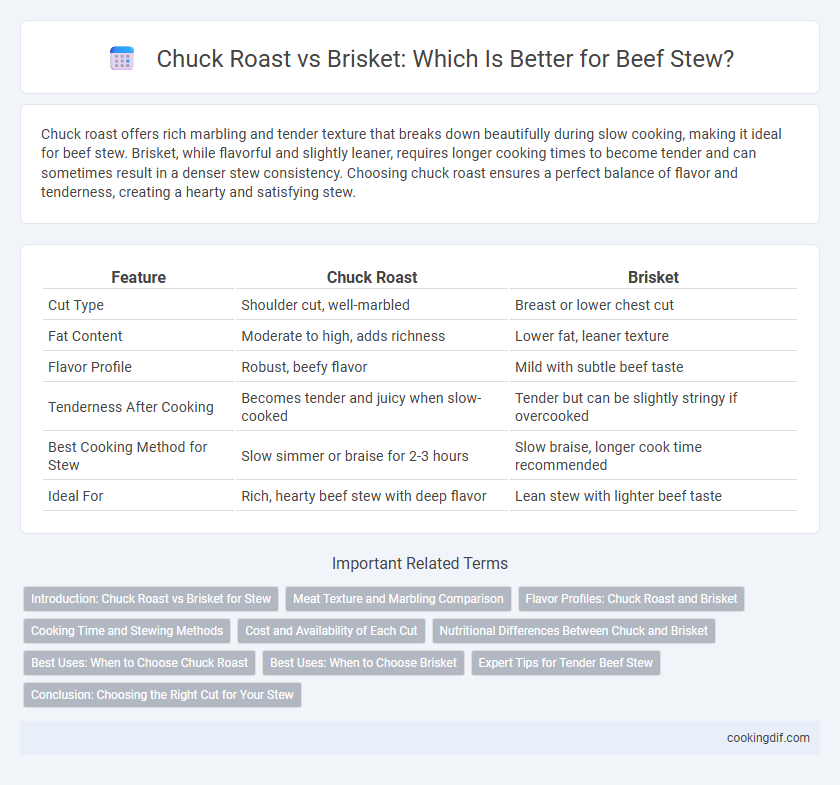Chuck roast offers rich marbling and tender texture that breaks down beautifully during slow cooking, making it ideal for beef stew. Brisket, while flavorful and slightly leaner, requires longer cooking times to become tender and can sometimes result in a denser stew consistency. Choosing chuck roast ensures a perfect balance of flavor and tenderness, creating a hearty and satisfying stew.
Table of Comparison
| Feature | Chuck Roast | Brisket |
|---|---|---|
| Cut Type | Shoulder cut, well-marbled | Breast or lower chest cut |
| Fat Content | Moderate to high, adds richness | Lower fat, leaner texture |
| Flavor Profile | Robust, beefy flavor | Mild with subtle beef taste |
| Tenderness After Cooking | Becomes tender and juicy when slow-cooked | Tender but can be slightly stringy if overcooked |
| Best Cooking Method for Stew | Slow simmer or braise for 2-3 hours | Slow braise, longer cook time recommended |
| Ideal For | Rich, hearty beef stew with deep flavor | Lean stew with lighter beef taste |
Introduction: Chuck Roast vs Brisket for Stew
Chuck roast offers a rich marbling of fat that melts into the stew, creating tender, flavorful beef with a succulent texture. Brisket, characterized by its dense, fibrous muscle, becomes tender and stringy when slow-cooked, adding depth to the stew's broth. Both cuts benefit from long cooking times, but chuck roast is often preferred for its balance of tenderness and taste in classic beef stew recipes.
Meat Texture and Marbling Comparison
Chuck roast features well-distributed marbling that melts during slow cooking, resulting in a tender, juicy texture ideal for beef stew. Brisket has a coarser grain with slightly less marbling, producing a firmer and more fibrous texture after long braising. Choosing chuck roast enhances stew richness and mouthfeel, while brisket adds a distinctive chew and robust flavor profile.
Flavor Profiles: Chuck Roast and Brisket
Chuck roast offers a rich, beefy flavor with ample marbling that melts into the stew, creating a deeply savory and tender texture. Brisket provides a slightly sweeter, more fibrous taste with a pronounced beefiness that adds complexity after long, slow cooking. Both cuts complement beef stew, but chuck roast tends to deliver a more robust mouthfeel, while brisket highlights nuanced, layered flavors.
Cooking Time and Stewing Methods
Chuck roast is ideal for beef stew due to its well-marbled texture that breaks down perfectly during long, slow cooking, typically requiring around 2.5 to 3 hours of simmering to achieve tender, flavorful results. Brisket, while flavorful, demands a longer cooking time of 3.5 to 4 hours and benefits from lower, slower stewing methods to avoid toughness and ensure the connective tissues fully dissolve. Slow braising in a covered pot with consistent low heat preserves moisture and enhances the rich, hearty character distinctive to both cuts when used in stews.
Cost and Availability of Each Cut
Chuck roast is generally more affordable and widely available at most grocery stores, making it a cost-effective choice for beef stew. Brisket tends to be pricier due to its popularity for smoking and barbecuing, and it may be less accessible in smaller or less specialized markets. Both cuts offer rich flavor, but chuck roast provides better value and easier sourcing for budget-conscious stew preparations.
Nutritional Differences Between Chuck and Brisket
Chuck roast and brisket offer distinct nutritional profiles that impact beef stew's health value. Chuck roast is higher in fat, providing more calories and a richer flavor, while brisket contains less fat and more connective tissue, contributing to a leaner stew with a chewier texture. Both cuts supply comparable protein levels, but chuck roast contains slightly more iron and zinc, essential for muscle function and immune support.
Best Uses: When to Choose Chuck Roast
Chuck roast offers rich marbling and connective tissue that breaks down during slow cooking, making it ideal for tender, flavorful beef stew. Choose chuck roast when you want a hearty texture and deep beefy flavor that melts in your mouth after hours of simmering. It withstands long cooking times better than brisket, ensuring a moist, succulent stew.
Best Uses: When to Choose Brisket
Brisket is ideal for beef stew when long, slow cooking methods are preferred to achieve tender, flavorful meat with a rich, gelatinous texture due to its higher collagen content. It excels in recipes requiring extended simmering or braising, allowing the connective tissues to break down and enhance the stew's depth of flavor. Choose brisket for hearty stews where a melt-in-your-mouth consistency and robust beef taste are desired.
Expert Tips for Tender Beef Stew
Chuck roast and brisket are both popular cuts for beef stew, but chuck roast is often preferred for its marbling, which breaks down during slow cooking to create tender, flavorful meat. Brisket can be used but requires longer cooking at low temperatures to avoid toughness due to its leaner composition and connective tissue. Experts recommend searing the meat before slow simmering and maintaining a gentle simmer to ensure maximum tenderness and rich stew flavor.
Conclusion: Choosing the Right Cut for Your Stew
Chuck roast and brisket each bring unique qualities to beef stew; chuck roast offers a tender, well-marbled texture that breaks down beautifully during slow cooking, infusing the stew with rich, beefy flavor. Brisket, while leaner and firmer, delivers a robust, slightly chewy bite that holds its shape well, ideal for those preferring distinct meat pieces in their stew. Selecting chuck roast optimizes tenderness and flavor absorption, making it the preferred choice for classic, hearty beef stew recipes.
Chuck roast vs brisket for beef stew Infographic

 cookingdif.com
cookingdif.com